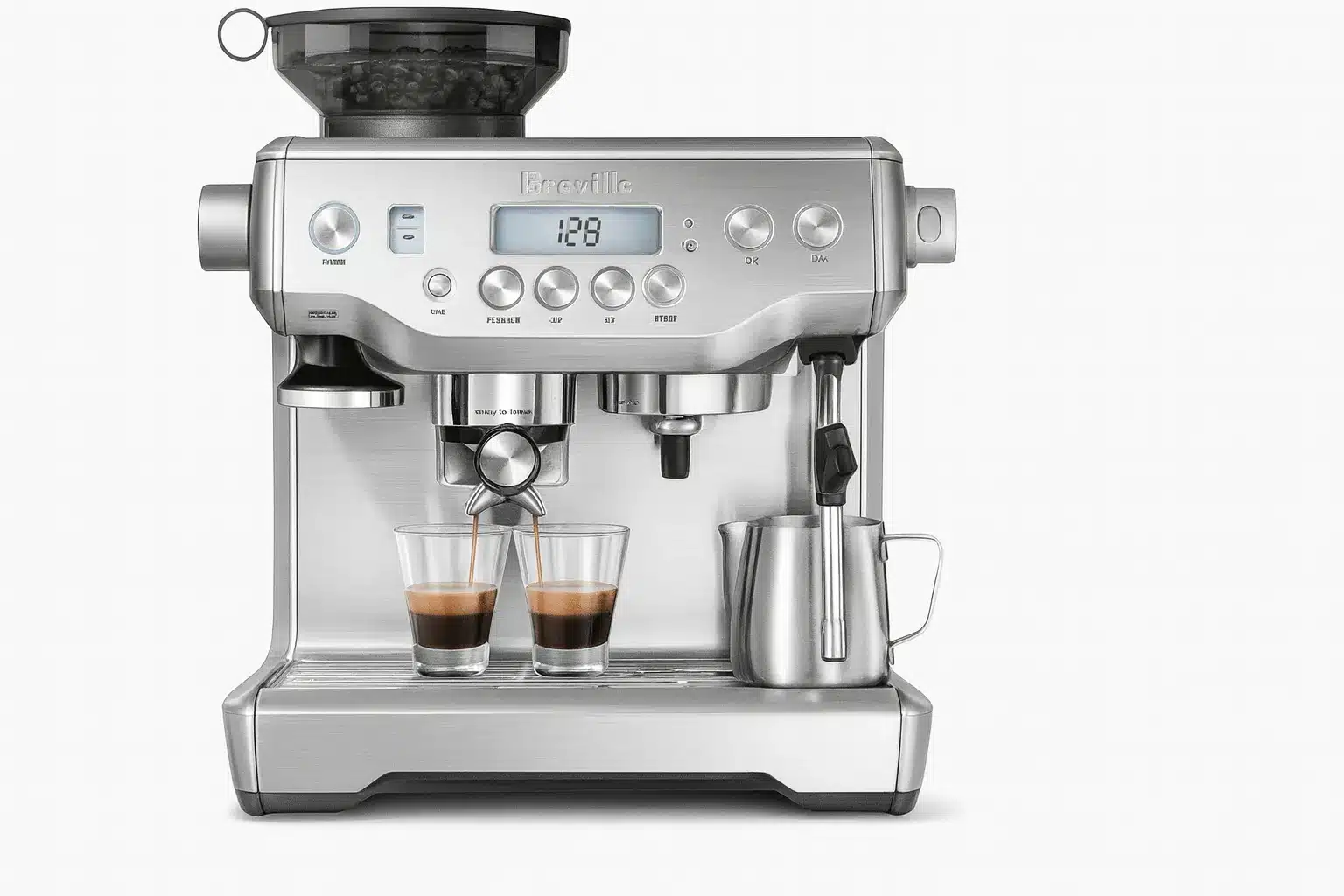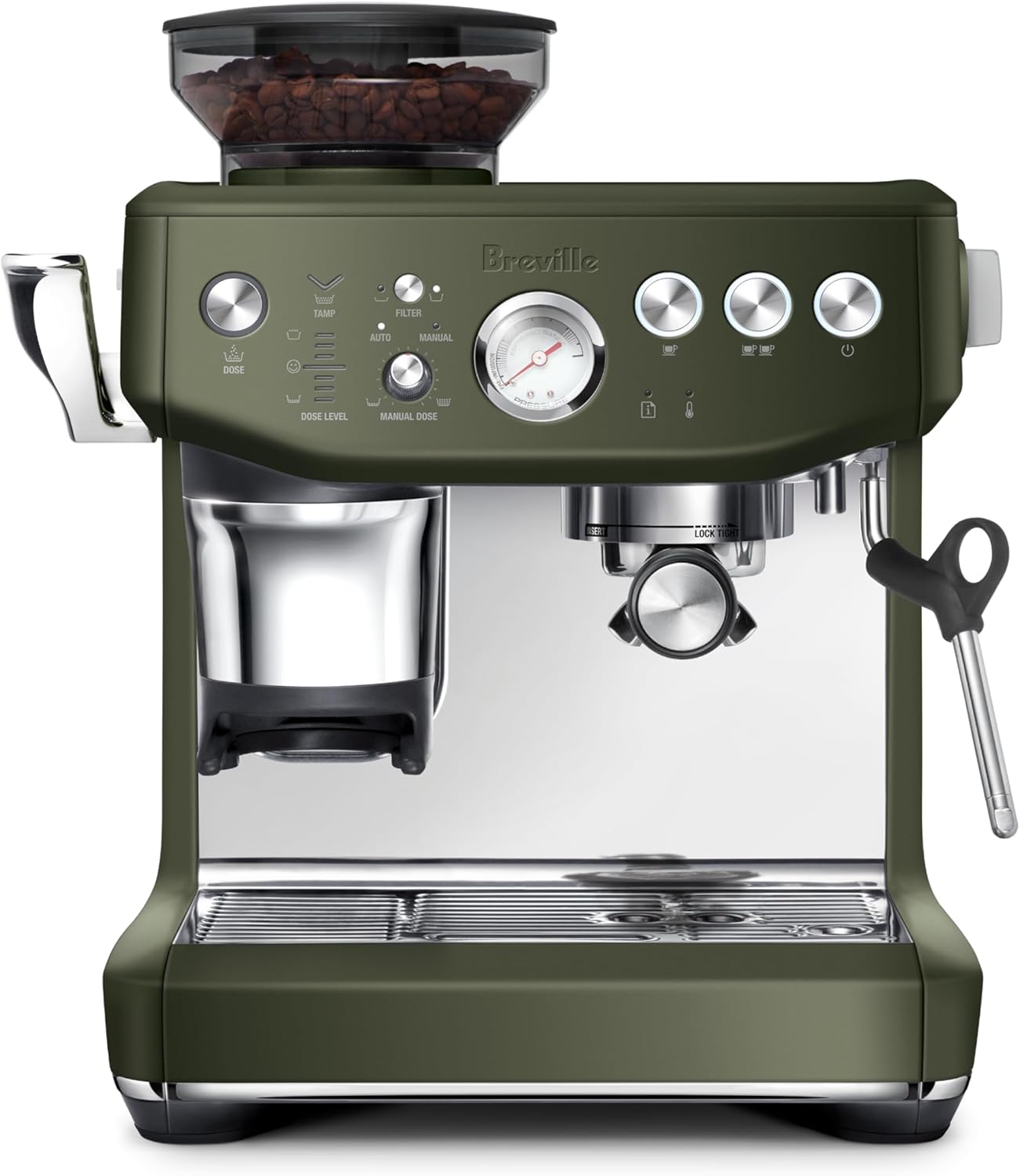
OneHundredCoffee is reader-supported, and some products displayed may earn us an affiliate commission. Details
I’ve spent the past several months living with the Breville Oracle Espresso Machine (model BES980XL), and I’m convinced it sits in that rare sweet spot between a barista’s toy and a household workhorse. It’s the machine I reach for bleary-eyed at 6 a.m., the machine I show off to friends on weekends, and the machine I rely on when I want café-level shots and silky microfoam without fuss. If you’ve ever craved the flavor and control of a prosumer espresso setup but hesitated at the learning curve, the Oracle’s mix of automation and manual craftsmanship is a game-changer.

Breville Oracle Espresso Machine (BES980XL)
Key Features
- Built-in conical burr grinder with automatic dosing & tamping
- Dual stainless-steel boilers with PID temperature control
- Low-pressure pre-infusion & ~9-bar extraction for balance
- Automatic milk texturing with adjustable temperature & foam
- 58 mm commercial portafilter; programmable 1–2 shots
Why We Like It
The Oracle streamlines café workflow at home—grind, dose, tamp, brew, and steam are integrated and highly consistent—while still letting you fine-tune temperature, shot volume, and milk texture.
Pros
- Hands-off grinding, dosing, and tamping
- Excellent temperature stability (dual boiler + PID)
- Powerful auto-steam with silky microfoam
- Commercial-style 58 mm workflow
Cons
- Large footprint on the counter
- Higher price and regular maintenance cycles
Bottom Line
A prosumer workhorse that automates the finicky steps without killing control—ideal for latte lovers who want speed, consistency, and café-quality texture at home.
Price on AmazonThe short story is this: the Oracle gives you a true dual-boiler, PID-controlled espresso engine with an integrated conical burr grinder and automatic dosing/tamping, plus hands-off milk texturing that actually produces latte-art-ready microfoam. The long story—the one I’m writing here—covers what it’s like to use every day, how each component performs, what I love, what’s fussy, and whether it’s worth it over close competitors. I’ll break down each part (size & design, colors, interface, water tank, grinder, portafilter, dosing, pre-infusion/boilers, cup clearance, tamping, temperature control, milk frother), then share my workflow, flavor notes, maintenance realities, a quick comparison table, a buyer’s guide, and a grounded conclusion based on real use.
Our Best Reviewed Breville Coffee and Espresso Machines
| Image | Product | Features | Price |
|---|---|---|---|
Best Automatic Espresso Machine  |
| Price on Amazon | |
Best Dual Boiler Value  |
| Price on Amazon | |
Best Assisted Tamping  |
| Price on Amazon | |
Best All-in-One Espresso Machine for Serious Home Baristas  |
| Price on Amazon | |
Best Mid-Range All-In-One  |
| Price on Amazon | |
Best Hands-Off Café Experience  |
| Price on Amazon | |
Best Touchscreen All-in-One  |
| Price on Amazon | |
Best All-in-One Starter  | Breville Barista Express Impress Espresso Machine (BES876BSS) |
| Price on Amazon |
Why the Oracle Stayed on My Counter
Espresso machines come and go through my kitchen, but very few earn permanent counter space. The Oracle did, and not because it’s the fanciest thing I’ve owned. It stayed because it nails the two things that matter most to me: repeatable quality and quick, low-effort results at 6 a.m. This is the first time I’ve had a setup that lets me be picky on Saturdays—tweaking pre-infusion, shot time, or brew temperature—yet still slam out consistent cappuccinos before work with zero mess on weekdays.
The magic is the combination of an integrated grinder with automatic dose and tamp, true dual boilers (so you can pull shots and steam milk at the same time), PID temperature control, and a steam wand that can texture milk on autopilot to a specific temperature and foam level. I still get to steer the flavor by adjusting grind size, dose, and brew temp, but I’m not burning time weighing grounds or tamping while I’m half awake. The result? Cafés have lost a regular customer.
Size & Design: Serious Machine, Thoughtful Footprint
On the counter, the Oracle looks like professional gear—clean lines, brushed metal, a proper group head, and a reassuringly solid stance that doesn’t skitter when you lock in the portafilter. It’s bigger than Breville’s entry-level models and closer to the footprint you’d expect from a dual-boiler setup. I slid it between a knife block and a wall cabinet without drama, but measure your space: width and depth are substantial, and you’ll want headroom for the bean hopper.
The design language feels purposeful. The drip tray is wide and surprisingly capacious; it includes the familiar “empty me!” indicator that pops up when it’s time to dump. The small details—like the tool storage behind the drip tray, the neatly routed power cord, and the soft, gentle angles—help make owning a large machine feel refined and sophisticated instead of industrial. It looks premium without shouting.
Everyday tip: park your most-used cups on the cup-warming tray; the machine radiates enough gentle heat up top to take the chill off the ceramic before you pull.
Colors: Understated and Kitchen-Friendly
The Oracle’s default look is that classic brushed stainless steel Breville finish that plays nicely with most kitchens. Depending on region and stock, you may see darker finishes or limited editions from time to time, but the stainless aesthetic is what the Oracle is known for—neutral, professional, and easy to keep looking clean with a quick microfiber wipe. If you’re chasing a fashion color, you’ll likely find more variety in Breville’s smaller machines; the Oracle’s vibe is “espresso tool,” not “kitchen jewelry.”
User Interface: Buttons, Dials, and a Clear Display (Not a Touchscreen)
If you’ve seen the Oracle Touch, that’s the one with the big color touchscreen. The BES980XL is different. It gives you a clear, information-rich display paired with physical buttons and knobs. I actually prefer this: I can adjust grind settings, shot volume/time, pre-infusion behavior, and brew temperatures with tactile controls I could use before coffee. The UI strikes a nice balance—enough programmability to make a nerd smile, without burying options behind a maze of menus.
You get a shot timer right on the face, easy access to single/double shot programming, and straightforward prompts for cleaning cycles. It feels like it was designed by people who pull shots before sunrise. If you like a bit of analog involvement—twisting a knob, hearing the grinder spin up, watching the timer tick—this machine scratches that itch.
Water Tank: Big, Accessible, and Friendly to Filtration
The reservoir is large enough that I can hammer out multiple milk drinks for guests without refilling. It’s removable for a full sink fill, but there’s also a convenient way to top it off without dragging the whole unit forward—handy under cabinets. If you’re in an area with hard water, get serious about filtration: either use the included filter system or fill with filtered water from the start. In my experience, good water is the difference between descaling twice a year and descaling constantly. Taste improves, too.
Everyday tip: make refilling part of your evening reset routine. Waking up to a full tank keeps mornings smooth.
Integrated Grinder: Conical Burrs, Sensible Adjustments, Real Consistency
If you’ve ever tried to dial in espresso on a separate grinder while juggling puck prep, you know misalignment and retention can waste time and beans. The Oracle’s integrated conical burr grinder puts dosing right over the 58 mm portafilter and keeps the mess minimal. Grind size adjustment is stepless enough for home use, with a range that has accommodated everything from dense light roasts to buttery medium roasts in my testing.
The biggest compliment I can pay this grinder is that I don’t think about it anymore. Once I find the sweet spot for a bag, I rarely touch the dial again until I switch beans. The path from hopper to basket is short, and the automatic dosing is consistent day-to-day. Is it as tweakable as a dedicated prosumer grinder? No. But it’s shockingly capable for being built-in, and the synergy with the Oracle’s auto tamping is why morning shots feel so repeatable.
What I learned: lighter roasts often want a slightly hotter brew temperature and a touch finer grind on this machine. Once I leaned into that, clarity popped.
Portafilter: Commercial-Style 58 mm, Solid and Familiar
The Oracle uses a substantial 58 mm portafilter—the same diameter you’ll find on many café machines. It’s heavy, nicely machined, and the spouts pour cleanly. The baskets are quality single-wall types, so you’re extracting real espresso, not relying on pressurized cheats to fake crema. If you already own distribution tools or 58 mm tampers from other setups, they’ll fit, but the whole point of the Oracle is that you won’t need a separate tamper.
Lock-in has that satisfying resistance that tells you the group gasket is healthy. The handle stays comfortable even after back-to-back shots. It’s the sort of portafilter that makes you want to pull “one more” just because it feels good.
Automatic or Manual Dose: The “Set-and-Forget” That Still Lets You Drive
This is where the Oracle earns its name. You grind directly into the portafilter, and the machine automatically doses and tamps to a consistent target. If you’re coming from a world of scales, WDT tools, and hand tampers, it feels like cheating—good cheating. The machine does the muscle memory parts; you decide the flavor via grind size (and, if you like, brew temperature and shot time/volume).
I mostly run the dosing on auto, taste the shot, and nudge the grind size a notch if needed. You can absolutely program shot volumes or brew by time if that’s your style. If you crave full manual weighing and tamping, this isn’t that machine—but the Oracle will still reward your inner tinkerer with control where it counts, while automating away the tedious steps that introduce human inconsistency.
Pre-Infusion & Dual Boilers: Café-Style Control at Home
The BES980XL is a real dual-boiler machine: one boiler for brewing and one for steaming. That means you can pull a shot while steaming milk with no performance penalty—no waiting for recovery, no milk scalding while your espresso sits. The brew boiler is PID-controlled for stability, and pre-infusion is part of the extraction logic, wetting the puck gently before full pressure ramps in. You can taste the difference in delicate coffees; channels are less frequent, and the first sip lands smoother.
For medium and darker roasts, the Oracle’s pre-infusion plus steady nineish-bar extraction produces a syrupy body and stable crema. On lighter roasts, a longer pre-infusion and slightly higher brew temperature coax out sweetness and cut the lemon-pith edge. I appreciate that the machine gives me the tools to adapt, rather than locking me into a single profile.
Cup Size & Clearance: Everyday Mugs Fit, Taller Vessels With a Trick
Cup clearance under the spouts is generous enough for standard cappuccino and latte mugs. For a tall travel tumbler or when I pull an Americano straight into a bigger cup, I remove the drip-tray grid to gain extra height. It’s a quick move and doesn’t feel hacky. Espresso nerds will still be happiest pulling into a pre-heated demitasse or shot glass for temperature stability, but the Oracle accommodates real-life mugs without gymnastics.
Tamping: Set, Spin, Done (and Consistent)
The Oracle’s integrated tamping is the unsung hero of weekday sanity. After the grind cycle, the machine compresses the puck to a consistent force and depth. There’s no guessing if you tamped too hard or too soft today compared to yesterday. No tilted pucks. No coffee dust snowstorm on the counter. I clean the rim with a quick wipe, lock in, and pull.
Does a hand-polish tamp produce a different feel? Sure—on purely manual setups, I sometimes do a light twist. On the Oracle, I don’t miss it. My sink tells me I waste less coffee, and my shots taste more uniform across the week.
Temperature Control: PID Stability You Can Taste
The Oracle lets you nudge brew temperature a few degrees to suit the roast, while PID control keeps the brew boiler from wandering once you’ve chosen your target. The steam boiler stays eager and ready; I’ve made back-to-back lattes for a crew without the steam power fading. If you’ve fought machines that yo-yo temperature or stall mid-steam, the Oracle feels like cruising in a car with cruise control—pick a speed and it holds.
My default? I aim slightly warmer for light roasts and notch down for chocolate-leaning medium roasts. The difference in cup is real: acidity becomes fruit, not sourness, and darker beans become fudge, not ash.
Milk Frother & Steam Wand: Auto Microfoam That’s Legit
Breville’s automatic milk texturing isn’t a gimmick here. You set a target temperature and a foam level, drop the tip in a pitcher, and the Oracle handles the stretching and rolling phases. When it beeps, you get glossy microfoam that takes latte art. On mornings when I want to play barista, I switch to manual steam and drive it myself. Either way, the wand has real power; I can texture a cappuccino pitcher in a handful of seconds.
Cleanup is enlightened: the wand auto-purges, and a quick wipe keeps it spotless. If you’re new to steaming milk, the auto mode will have you pouring hearts long before you would on a fully manual wand. If you’re experienced, you’ll appreciate that auto mode is actually good enough for daily use.
Daily Workflow: From Bean to Cup (What It’s Like to Live With)
- Warmup & cups: The machine wakes quickly and holds temp; I place my cups on the top to warm.
- Grind-dose-tamp: Insert the portafilter; the grinder doses, the machine tamps.
- Pull: I start the shot and watch the timer. If it runs short or long, I tweak the grind size for the next round.
- Steam: While the shot runs, I steam milk on auto to my preferred temp.
- Pour & enjoy: Latte art is optional before emails.
- Quick tidy: Knock puck, rinse basket, wipe wand, empty drip tray as needed.
That’s it. No scales, no fluffy WDT routine at 6:05 a.m., no elbow-grease tamping. On weekends, I’ll go nerdy—try another temperature, experiment with pre-infusion, or swap beans and redial. The Oracle flexes with me.
Taste & Performance: What’s in the Cup
With a chocolate-hazelnut medium roast, I consistently get syrupy shots with a nutty nose, caramel sweetness, and a cocoa finish—classic café comfort. With a lighter, fruit-forward roast, the Oracle rewards careful temperature and grind with peach or berry notes and balanced acidity. Milk drinks shine; the automatic microfoam integrates rather than sitting as froth on top, so my cappuccinos taste velvety instead of airy.
Is it the last word in clarity for ultra-light Scandinavian roasts? Dedicated flat-burr prosumer grinders paired with pressure-profiling machines may tease out even more nuance—but for a one-box home system, the Oracle punches way above convenience-machine territory and lands squarely in “serious espresso” land.
Noise, Speed, and Heat Management
Grinding is audible but not jarring—typical of a conical burr unit. Pump noise is controlled; shot audio is more of a calm hum than a rattle. From idle to first drink is pleasantly fast for a dual-boiler design, and recovery between back-to-back drinks is effectively instant. The chassis gets warm but never worryingly hot to the touch; the heat is where it belongs—inside the boilers and on the cup warmer.
Cleaning & Maintenance: Realistic for Daily Life
- After each use: Knock the puck, rinse the basket, wipe the wand. The auto-purge is helpful.
- Daily/weekly: Empty the drip tray; wipe the machine. Brush out the grind chute occasionally; it has less retention than many standalones, but coffee is coffee.
- Backflushing: The Oracle prompts cleaning cycles. Follow them; it keeps valves happy and shots tasting consistent.
- Descaling: It depends on your water. Filtered water plus the in-tank filter stretches intervals.
- Gaskets & parts: The group gasket and shower screen are standard wear items; replacing them periodically is routine espresso ownership.
Nothing in the maintenance routine feels out of step with the machine’s promise of convenience. If anything, the guided prompts lower the barrier for first-time owners.
Strengths & Quirks (From Real Use)
What I love
- Legit dual-boiler performance with café-style stability.
- Automatic dose/tamp that actually works and removes morning variability.
- Auto milk texturing is good enough for latte art and daily consistency.
- 58 mm ecosystem and a serious build give it a professional feel.
- Thoughtful UI: clear, fast, tactile.
What’s fussy
- It’s a large, premium machine—measure your space and your expectations.
- If you thrive on full-manual puck prep rituals, the Oracle will feel “too helpful.”
- Switching beans means a couple of test shots to redial (true of any serious setup).
- You’re buying into an integrated grinder: wonderfully convenient, but not swappable like a separate unit.
Who the Oracle Is For
- Busy espresso lovers who want café-level drinks before work with minimal cleanup.
- Beginner-to-intermediate home baristas who want training wheels that don’t cap potential.
- Hosts and households where multiple back-to-back milk drinks are common.
- Tinkerers with limits—you want real control over temperature and extraction, but you don’t want to weigh and tamp at 6 a.m.
If you want total manual control, a bare-bones prosumer machine plus a separate high-end grinder may suit you better. If you want full push-button superautomatic simplicity, look at a bean-to-cup machine. The Oracle lives powerfully in between.
Quick Comparison: Oracle vs Close Competitors
Note: Key traits and “feel” in real use. Exact feature sets vary by model/version.
| Machine | Boilers/Heating | Grinder | Automation Highlights | Milk System | Best For |
|---|---|---|---|---|---|
| Breville Oracle BES980XL | Dual boilers, PID brew & steam | Integrated conical burr | Auto dose & tamp; programmable shots; pre-infusion | Auto & manual steam; microfoam | Café-level espresso with real convenience |
| Breville Oracle Touch | Dual boilers, PID | Integrated conical burr | Touchscreen recipes; more guided automation | Auto & manual steam | Same cup quality, more touch-driven ease |
| Breville Dual Boiler (no grinder) | Dual boilers, PID | — (separate grinder needed) | Manual dose/tamp; pro-style workflow | Manual steam | Purist control if you already own a grinder |
| De’Longhi La Specialista-class | Dual heating systems (non-dual-boiler) | Integrated | Assisted tamping; faster start | Manual/assisted steam | Quick “espresso-like” drinks; simpler learning curve |
| Superautomatic (e.g., Jura) | Thermoblock/varies | Integrated | One-touch drinks; minimal control | Auto milk systems | Maximum convenience, less shot customization |
Why I’d still pick the Oracle: it’s the rare machine that keeps real espresso control intact while removing the messiest variables (dose/tamp/steam timing). If you’re taste-driven but time-limited, it’s the sweet spot.
Customer Guide: How to Get the Best From the Oracle
1) Pick beans wisely.
Freshly roasted whole beans (ideally within 2–6 weeks of roast date) make the biggest difference. Start with a medium roast while you learn; it’s forgiving and delicious.
2) Dial in with a plan.
- Start at a middle grind setting.
- Pull a test shot: aim around 25–30 seconds from the first drip for a double.
- If it gushes fast, go finer; if it chokes or drips, go coarser.
- Taste and adjust brew temperature a notch if a light roast tastes sour (go slightly hotter) or a dark roast tastes bitter (go slightly cooler).
3) Use the automation smartly.
Let the Oracle handle dosing and tamping; adjust the grind for taste. Program shot volume/time once you find your sweet spot, and your mornings will fly.
4) Milk mastery in auto.
Choose a milk temp that tastes sweet (often mid-60s °C) and a foam level that suits your drink (denser for cappuccino, silkier for latte). The auto-texturing is genuinely good—embrace it.
5) Water matters.
Filtered water improves taste and reduces scale. Keep the in-tank filter fresh.
6) Keep it clean.
Wipe, purge, and empty the tray routinely. Run the cleaning cycles when prompted. A clean machine is a tasty machine.
7) Don’t chase perfection, chase repeatability.
The Oracle excels at giving you the same excellent drink every morning. That consistency is the hidden luxury.
Frequently Asked Real-World Questions
Does the Oracle replace a separate grinder?
At home, yes. Its integrated conical burrs are consistent and paired perfectly with the dosing/tamping system. If you already own a boutique grinder, you’re probably shopping the non-grinder Dual Boiler anyway.
Is it beginner-friendly?
Shockingly so. The learning curve is more about coffee taste than machine operation. You can grow into more control over time without feeling overwhelmed on day one.
How fast can I make milk drinks for guests?
Dual boilers mean you can pull shots and steam simultaneously. I’ve served a table of four lattes in minutes without the machine breaking a sweat.
Will I outgrow it?
Only if your hobby becomes a laboratory. For daily life—even enthusiastic daily life—the Oracle’s ceiling is high.
Personal Opinion & Experience: What Kept Me Coming Back
I went into this review expecting to respect the Oracle and end up missing the ritual of my fully manual setup. I left surprised by how much more espresso I actually drank—and how consistently good it tasted. On a Tuesday morning before a big day, there’s something comforting about knowing my cappuccino will be exactly right, no mess, no mental math, no “oops, tamped crooked.” On Saturday, I still get to play—switch beans, push brew temp, tweak pre-infusion—and the machine responds with nuance.
My favorite routine became absurdly simple: medium roast, grind dialed just right, auto tamp, 28-ish second shot, auto-textured milk to a temperature that hits the milk’s sweetness peak. The cup is velvety, chocolate-forward, with a lingering caramel finish. It’s the flavor I hoped café drinks would deliver—and often don’t.
Is it cheap? No. Is it worth it? If espresso is part of your daily rhythm, the Oracle pays you back in time saved, drinks improved, and mess avoided. It made me drink better coffee, more often, with fewer excuses. That’s a recommendation from lived-in use, not just a spec sheet.
Conclusion: A Machine That Earns Its Space (and Then Some)
The Breville Oracle BES980XL is the rare all-in-one that takes the soul of espresso seriously. Dual boilers, PID, a real 58 mm portafilter, and thoughtful pre-infusion live alongside an integrated grinder and automatic dose/tamp that erase the most inconsistent parts of home barista life. Add in genuinely excellent automatic milk texturing and a user interface that’s all signal, no noise, and you have a machine that’s both a teacher and a teammate.
If you want the artistry of espresso with the practicality of a morning routine, the Oracle deserves a spot at the top of your shortlist. It’s the machine I kept on my counter after the review ended—because it made my coffee better, and my mornings easier.
TL;DR (for the skimmers)
- What it is: A dual-boiler, PID-controlled espresso machine with an integrated grinder, automatic dosing/tamping, and automatic milk texturing.
- Why it’s great: Café-level results, weekday convenience, weekend tweakability.
- Who it’s for: Taste-driven people who want repeatable excellence without the mess and micromanagement.
- Bottom line: The Oracle delivers real espresso joy with far less effort—and that’s what keeps you brewing.






